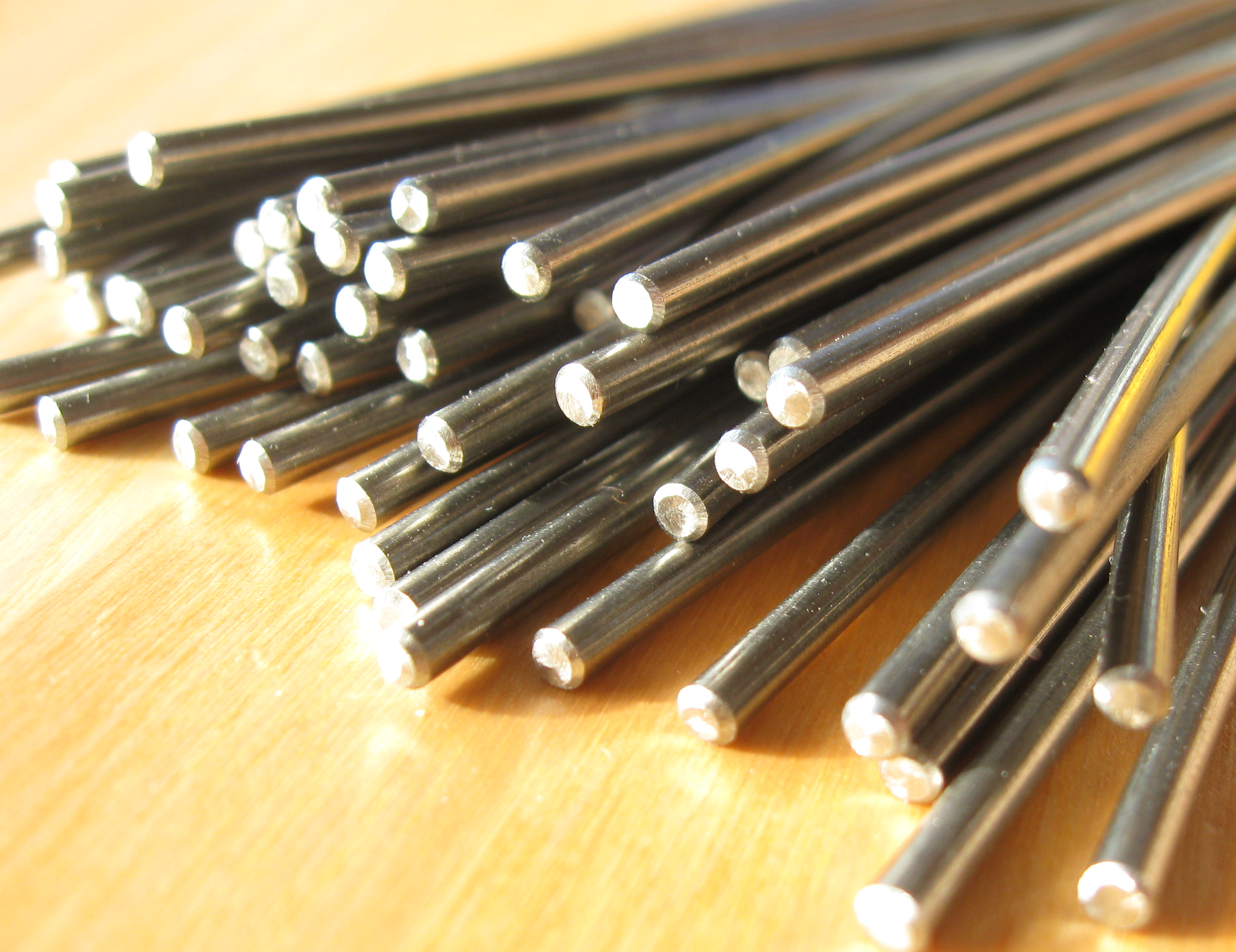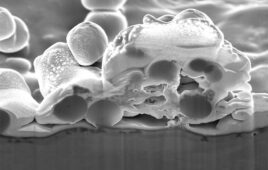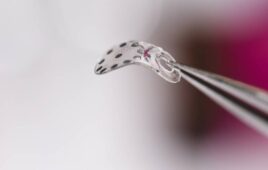Dissolvable films are currently used in a variety of applications such as consumer breath freshener products and as vehicles for over-the-counter drug delivery. Manufacturers are also exploring the technology’s unique characteristics for use with in vitro diagnostic devices. This article reviews the physical properties of dissolvable films and explores its usage in this method.
By Cathy Moritz
 The formulation of dissolvable films from aqueous polymer matrices across a wide molecular weight range allows for formulation flexibility to achieve a variety of physical properties that can be useful to medical device manufacturers. |
At a Glance
Dissolvable films are not new to the marketplace. They have been available for a number of years in the cosmetics industry and, with the launch of the Listerine PocketPaks breath strips, this product form was introduced to the mainstream public. Numerous other manufacturers quickly followed suit with their own versions of breath freshening strips and, most recently, pharmaceutical companies have incorporated over-the-counter compounds into dissolvable films for the delivery of cough/cold medications and antacids. Other markets have realized the potential advantages of dissolvable films and are attempting to utilize this technology to expand their available product lines. Diagnostic device manufacturers are among those that can benefit from this platform.
Dissolvable Film Design
The supporting layer for dissolvable films is formed from an aqueous polymer matrix. Cellulose derivatives, hydrocolloids, acrylate copolymers, gums, and polysaccharides are a few examples of the many chemistries available to the formulator. Water solubility, good film forming capability, safety, variety, molecular weight range, and compatibility make these materials efficacious in many applications. Availability of the polymers across a wide molecular weight range allows for formulation flexibility to achieve a variety of physical properties including film strength and disintegration rate (or dissolution). Combining low molecular weight with high molecular weight polymers allows for optimization of physical properties. The ability to adjust these ratios and formulate with a variety of combinations of water soluble polymers provides substantial latitude to the developer. The addition of a plasticizer/humectant may be needed to increase film flexibility and dimensional stability and often times other additives act to influence film formation.
Properties of Dissolvable Films
Characteristics such as thickness, dissolution rate, surface characteristics (texture), and mechanical properties (film strength) are able to be tailored for dissolvable films. Physical attributes are greatly affected by the molecular weight (Mw) of the water soluble polymer(s) in the film base. Additives present in the dissolvable film formulation will also play a role in defining final properties. For instance, increased disintegration time and mechanical strength are expected from films comprised of either high Mw polymer(s) or ones with a greater ratio of high Mw to low Mw polymer. Conversely, when a film consists of either low Mw polymer(s) or a higher ratio of low Mw polymer to high Mw polymer, the result is decreased disintegration time and film strength. In addition, high concentrations of non-film forming additives will also decrease film strength and compromise dissolution time. Thus, there is a balance that exists between film strength and disintegration rate.
| Identification |
Compositional Information
|
Disintegration
Time (sec) |
|||
|
Low Mw
Cellulose |
Low Mw
Polymer |
High Mw
Cellulose A |
High Mw
Cellulose B |
||
| Example A |
1
|
–
|
–
|
–
|
18
|
| Example B |
1
|
0.9
|
–
|
–
|
8
|
| Example C |
1
|
1
|
–
|
–
|
5
|
| Example D |
–
|
–
|
1
|
1
|
24
|
| *Note: Test average of n=4; polymer content provided as ratio | |||||
Thickness and mass also play a role in determining physical properties of dissolvable films. Constructions comprised predominantly of low Mw water soluble polymer(s) at different thicknesses will result in a range of disintegration rates and mechanical strengths. The table illustrates the influence of molecular weight on film solubility. A combination of low Mw cellulose and low Mw polymer reduces disintegration time. The effect appears substantial as additional low Mw polymer is added. The opposite effect is observed with a combination of high Mw cellulose polymers. Although they tend to impart good mechanical properties, disintegration time is increased.
Additional ingredients can be incorporated into the desired polymeric base to meet the needs of the product design. Potential additives include flavors, fragrances, colorants, enzymes, surfactants, buffers, thickeners, stabilizers, and fillers. For some product ideas, design inputs may require the inclusion of a variety of specific additives in the film. In these cases, the compatibility of the ingredients with the polymer base formula may pose a challenge to the formulation scientist.
Applications
Dissolvable films are currently available on the market for several different applications including breath fresheners, cleansers, and OTC drug delivery. Other markets that can benefit from this technology include diagnostics, where device designs could incorporate reagent chemistries in dissolvable films and offer many potential advantages over current designs.
 Dissolvable films could be used to incorporate reagents into medical diagnostic devices such as lateral flow and microfluidic devices, and microtiter plates. |
For instance, pre-measured single dosing creates both ease of use and less waste of material. Concentrated doses can be achieved by high loadings within the film or increased film mass and thickness. Dissolvable films containing reagents allow for more efficient use by providing less waste due to precise containment of the reagent within the diagnostic device. These films potentially improve cost effectiveness by decreasing waste due to strip segmentation. Due to the lack of an aqueous carrier, the need for preservatives is eliminated. The stability of reagents may be improved when incorporated into a dry dissolvable film. Continuous web processing, which allows for easier handling, is enabled with cast films.
In diagnostic devices, dissolvable films allow for the incorporation of reagents into lateral flow and microfluidic devices and microtiter plates. Dissolvable films can also be used as isolation barriers to separate various reactive components or act as a protective coating that dissolves to expose the active. Precise dosing of the reagent is also possible with dissolvable films. Device design options are increased to include possible vertical flow and layered configurations when using dissolvable films. Also, films allow for easier handling than reagents contained within a solution. Dissolution rates can be used to control release of reagents within these devices.
Conclusion
Dissolvable films are being utilized in many markets. Selection of a polymeric base involves identifying a system that provides the desired properties. Balancing high and low molecular weight water soluble compounds will alter the film physical properties including mechanical strength and disintegration rate. Dissolvable films offer numerous advantages to diagnostic devices and applications. Several of these advantages are improved stability of the reagent, higher efficiency due to continuous web processing, precise dosing, increased choice of device designs (including vertical flow and layered configurations), and controlled release of reagents.
Online
For additional information on the technologies and products discussed in this article, visit Adhesives Research at www.adhesivesresearch.com.
Cathy Moritz is a product development chemist for the ARcare® Division of Adhesives Research, 400 Seaks Run Rd., Glen Rock, PA 17327. She holds a dual degree in biology and chemistry from Immaculata University and has been with the company for eight years. Adhesives Research is a manufacturer of pressure-sensitive adhesives and related products. Moritz can be reached at 800-445-6240 or cmoritz@arglobal.com.




